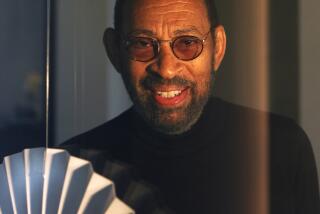Alfred Desio, 74; performer and teacher invented way to electrify tap-dancing’s sound
- Share via
Tap performer, teacher and innovator Alfred Desio, a multitalented artist who began dancing at age 3 and gained his greatest fame for developing a method of electronically transforming the sound of tap steps, died Wednesday at Olympia Medical Center in Los Angeles of complications from cancer. He was 74.
He was born Aug. 29, 1932, in Geneva, N.Y., and quickly became a child prodigy. A Geneva newspaper noted, “Someday, Alfred Desio may be widely known, and that, at the age of 4, is his solemn ambition.” The article also mentioned that at one performance, Desio stopped dancing to demand that the applauding audience be quiet because “I can’t hear the music.”
Although tap was his first love, Desio soon developed other dancing abilities that landed him jobs in the original Broadway productions of “West Side Story,” “Fiddler on the Roof,” “Man of La Mancha,” “Kean,” “She Loves Me,” “Donnybrook,” “Zorba” and “Coco.” He also performed frequently with jazz bands and symphony orchestras and worked as an assistant to Joseph Pilates, the originator of the Pilates exercise technique.
After moving to Los Angeles in the early ‘70s, Desio began teaching tap and movement for actors at a number of Southern California institutions and, for the last 30 years, served on the dance faculty at the Colburn School of Performing Arts in downtown L.A.
With his wife, choreographer Louise Reichlin, he also ran and performed in Los Angeles Choreographers and Dancers, a company that alternated Reichlin’s modern dance creations with Desio’s tap pieces. It was there that local audiences found him developing Tap-Tronics, a way of radically altering and expanding the sound of tap-dancing.
Desio told The Times in 1993 that he began working on the idea in 1982 while doing a radio promotion for a dance festival. “The radio engineer put my taps through a delay,” he said, “and it was suddenly very obvious to me that if you could take that sound and then process and control it, you could create interesting rhythm ideas that were almost musical, rather than just the rat-a-tat tap sounds.”
A few years later, Desio brought what he called his Zapped Taps to about 6,000 people in a performance for Lincoln Center Out of Doors in New York. And in 1989, tap star Gregory Hines used a version of Desio’s Tap-Tronics in the feature film “Tap.” On the set, Desio was a consultant “to make sure the tap shoes worked,” he said.
But for all the attention that technology brought Desio, it was his talent as a dancer that won him accolades. In a 1987 review for the New York Times, Jennifer Dunning wrote, “An overbearing bank of machines with winking colored lights are likely to be of greatest interest to electronic whizzes.... But in the end it is the cagey exuberance of this leprechaun tapster that makes the work so enjoyable.”
A commemorative event honoring Desio is scheduled for March 4 at 3 p.m. at the Colburn School, 200 S. Grand Ave. He will also be honored May 6 by the Dance Resource Center with its Excellence in Teaching award at the Alex Theatre, 216 N. Brand Blvd., Glendale.
More to Read
The biggest entertainment stories
Get our big stories about Hollywood, film, television, music, arts, culture and more right in your inbox as soon as they publish.
You may occasionally receive promotional content from the Los Angeles Times.










